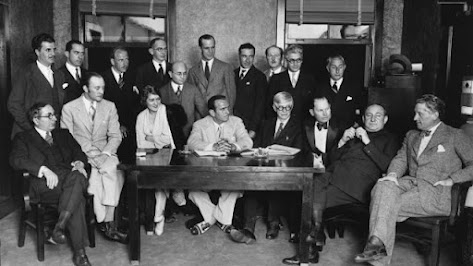Celebrating Cinema: The Oscars
Behind the Ceremony: Secrets and Curiosities of the Oscars
The Oscars,
officially known as the Academy Awards, were created by Louis B. Mayer, Metro-Goldwyn-Mayer's (MGM) director, in 1927. Mayer's primary motivation in
establishing the Academy of Motion Picture Arts and Sciences (AMPAS) was to
manage disputes within the film industry and prevent talent from unionizing.
Initially, the awards were intended as a distraction to keep the focus of
studio talent away from unionization efforts. Mayer believed rewarding filmmakers would motivate them to produce films aligned with his vision.
Who was the first person to win an Oscar?
To maintain
credibility in their new awards, the Academy of Motion Picture Arts and
Sciences faced a dilemma when the top-voted "actor" for the first
Oscar for Best Actor was a dog named Rin-Tin-Tin. Concerned about the award's
legitimacy, the film board diverted the 1929 Oscar to Emil Jannings instead, who received the Best Actor award for
his work in the silent films 1928 "The Last Command" and "The Way of All Flesh" at the inaugural Academy Awards in 1929.
Who won the first Oscar for Best Picture?
The
Statuette:
- The statuette, officially named the Academy Award of Merit but more popularly known by its nickname, "Oscar," is a gold-plated knight holding a sword and standing on a five-spoke film reel.
- The design of the statuette, a
knight holding a sword and standing on a film reel, has remained unchanged
since its inception. However, the size of the base varied until the
present standard was adopted in 1945.
- The origin of the nickname
"Oscar" is unclear. Still, it is believed to have originated from
Hollywood columnist Sidney Skolsky, who first used it in his 1934 article
referring to Katharine Hepburn's first Best Actress win. The
Academy itself didn't use the nickname officially until 1939.
Interesting
Facts:
- The ceremony was first
broadcast on radio in 1930 and television in 1953.
- When the ballot results came in
to decide the first winner of the Oscar for Best
Actor, the Academy of Motion Picture Arts and Sciences realized they faced
a tricky problem. The “actor” who had collected the most votes was a dog
called Rin-Tin-Tin,
who had starred as Rinty in popular films such as A Dog of the
Regiment and Jaws of Steel. The film board was
concerned that awarding the first statuette to a canine would hardly give
credibility to their new awards. To avoid barking mad, they diverted the
1929 Oscar to Emil Jannings.
- The number of award categories
has fluctuated over the years but currently stands at 23.
- Some of the most iconic moments
in Oscar history include:
- Marlon Brando refused his
Best Actor award in 1973 in protest of the treatment of Native Americans
in the film industry.
- Whoopi Goldberg's colorful and
comedic hosting stints in the 1990s.
- The historic wins of black actors such as Halle Berry, Denzel Washington, and Chadwick Boseman.
In 1940,
Hattie McDaniel became the first African American actress to win an Oscar for
her groundbreaking supporting role as Mammy in Gone with the Wind. McDaniel's
performance helped pave the way for many black actors in cinema.
Sidney
Poitier was the first Black man to win the Academy Award for Best Actor.
- Over the years, the number of
award categories has increased, with the current ceremony featuring 23
categories.
- The ceremony has also grown
into a global cultural event, attracting millions of viewers worldwide. It
is known for its red carpet, celebrity appearances, and emotional
acceptance speeches.
The Oscars
remain a major cultural event, attracting millions of viewers
worldwide. They remain a significant force in shaping the film industry and
celebrating the achievements of filmmakers and actors.







Comentarios
Publicar un comentario